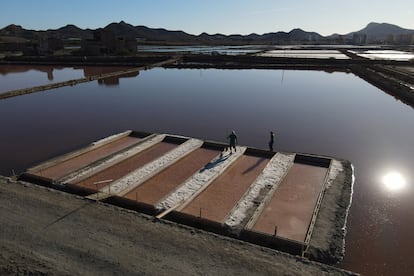When in 1993 the Salinera Catalana company stopped exploiting the Marchamalo salt flats, in the extreme south of La Manga del Mar Menorthe Southeastern Naturalists Association (ANSE), one of the oldest environmental entities in Spain, has already warned of the environmental deterioration that the abandonment of this activity would entail and began to fight for its recovery. It has taken 30 years, but the work has borne fruit: last September, ANSE collected a harvest of 1,500 tons of salt from those salt flats, despite the fact that it only manages a small part of them, about 8 hectares. of a total of 64. The dream of environmentalists is to make the entire network of ponds and canals alive again.
”If with a small investment, in just a year and a half, we from an environmental association have managed to recover a natural asset, which is also compatible with a traditional economic activity, it is clear that the recovery can be extended to the rest of the complex, and that “It can be repeated in other salt mines in the area,” explains Pedro García, director of the association at the foot of the mountain of salt that they have collected in this first campaign.

Although ANSE had the Marchamalo salt flats in its sights since their abandonment, García marks the year 2012 as a turning point, when part of the ponds dried up completely, seriously affecting the fauna and flora that surrounded them. The environmental entity carried out various protests in the area that resulted in the autonomous community taking on water pumping to prevent the ponds from drying out again. In that year, ANSE also learned that part of the salt flats were in the public maritime-terrestrial domain and began the procedures to obtain the concession of those lands. It wasn’t until 2019 when he achieved it: Based on campaigns, they raised about 80,000 euros with which they bought the concession to manage eight hectares of the salt mines, and other plots of about 7,500 square meters, in which there were several semi-demolished warehouses.
The big boost came in 2022, when ANSE, together with WWF and the Spanish Institute of Oceanography, accessed European aid from the Recovery, Transformation and Resilience Plan to launch a broader ecosystem recovery project in the Mar Menor environment called Highlightwhich included the recovery of the salt mines, and for which they have obtained 1.7 million euros. These funds gave them wings to start working, in March 2023, to dredge sludge and sediment from the salt ponds, build water channels and rebuild the dry stone walls that separated the ponds, as well as the perimeter walls, eliminate electrical towers , extract about 500 tons of materials from the Sierra Minera, install pumps for the water supply and rehabilitate one of the acquired warehouses, among other actions. All this to enable only 40% of the total concession of the environmentalists, who plan to begin the recovery of the rest of the ponds starting next December. But García considers that the project has already had a great impact on the landscape, is beginning to have an impact on the recovery of biodiversity, and will also be a source of employment in the area. At the moment, two people work permanently at the salt mine: Julio Calderón, a salt farmer, and Mar Celdrán, a biologist.

Calderón is 52 years old and has been living just 50 meters from the land acquired by the environmentalists since he was 7. A carpenter by training, he remembers sneaking into the salt mines as a child to see up close the spectacle of those white mountains that were transported in trucks to the neighboring town of Cabo de Palos, where a small dock was built to carry the salt on barges to enormous salt ships that distributed it throughout Spain. Celdrán knows the history of the salt mines inside out, since his grandfather, Francisco Celdrán, was the manager of Salinera Catalana. The photographs from the family archive show the old wagons with which the mineral was transported, the “saleros” or stone deposits built in Cabo de Palos to store it, and the manual work, based on shovels and hooks, to extract the salt from the bottom of the ponds.
Calderón has had to learn the trade from scratch, advised by the company Salinera Española, which exploits the only salt mine that is still active in the area of the Mar Menor, that of San Pedro del Pinatar. The work is reminiscent of agriculture, because it depends largely on the weather, and requires constant supervision: the water from the Mar Menor reaches the ponds directly through pumping channels with a salinity of 5 degrees Baumé and, to crystallize, that salinity should rise to about 26 degrees. Salinity increases in the heating ponds and the activity then moves to the crystallizing ponds, where the degrees must be maintained by adding or removing water. The salt crystallizes in layers, creating authentic stones, hard and sharp.
For the extraction of this first campaign, ANSE hired specialized machinery and operators to avoid the hard work involved in extraction by hand. A job that clearly remembers, at 85 years old, Pedro Martínez Peñalver, who everyone in the area knows as The Baby of the Salinasin which he worked from the age of 15 until his retirement, 46 years in total. “It was very heavy work, with a shovel and carrycot. The salt was picked with lockpicks and mounted on wagons, which were on rails pulled by mules. They took it in cars to Cabo de Palos and between four men we loaded it on a barge to take it to the salt ships,” he explains with passion. “Everything was done in July and August. In the winter they worked on the rafts, which were boarded with mules to leave the floor smooth. The salt came out better when there was wind. If there was no wind, a cloth would form on the surface that had to be removed,” he says. As he says, he is glad that environmentalists have begun to recover the area, but he sees it as difficult to be able to put into operation the entire surface that he knew in his youth, although he breaks out in favor of the project: “The best salt was the one here. Not like the one in San Pedro and those in Alicante. Like the one here, none,” he insists, emphatically.

This year’s environmentalists’ harvest, for the moment, does not have authorizations to be marketed for human consumption. However, García is confident that its exploitation will allow the salt mine to be self-financing in future campaigns. The dream of the environmental group now involves extending its project to the entire salt mine, which includes another 16 hectares of public domain and about 40 of private property, in which there are various warehouses and the remains of a mill for grinding salt, the only one left in the area. ANSE has requested the concession of the remaining hectares of public domain and has been “in talks” with the owners of the private part for some time. “In a very defeatist context like the one around the Mar Menor, where it seems that nothing can be recovered, we have shown the opposite: that a completely abandoned place can be recovered, respecting the heritage and the landscape. After this experience, yes, we dare to do the rest,” he emphasizes.

